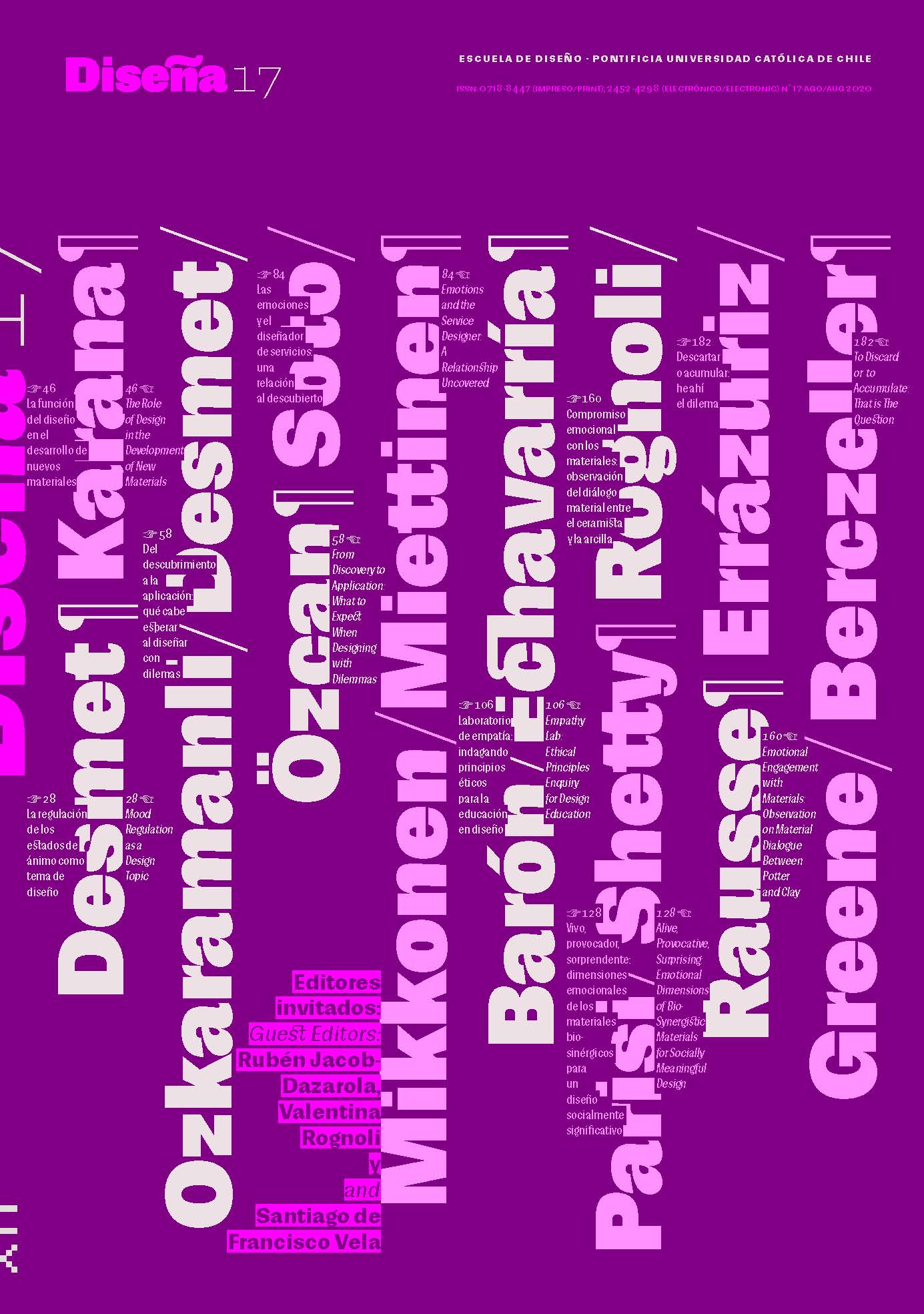From Discovery to Application: What to Expect When Designing with Dilemmas
Main Article Content
Abstract
Personal dilemmas are inspiring phenomena, which can stimulate design creativity and reflection on users’ goals and values. This paper aims to provide an overview of the main challenges involved in Dilemma-Driven Design (DDD). We first introduce three main activities performed when designing with dilemmas: Identifying dilemmas (discovery), selecting a target dilemma (definition), and generating ideas to address the selected dilemma (application). Next, we present a design case in which thirty novice designers responded to a project briefing in three consecutive workshops. Their experiences were evaluated through a questionnaire and a group discussion, resulting in an overview of five challenges involved in designing with dilemmas and recommendations on how to tackle each challenge. Based on our findings, we discuss how DDD is positioned as an emerging, conflict-inspired design approach. Altogether, this paper acts as an ‘introductory course’ on DDD.
Downloads
Article Details

This work is licensed under a Creative Commons Attribution-ShareAlike 4.0 International license.
COPYRIGHT NOTICE
All contents of this electronic edition are distributed under the Creative Commons license of "Attribution-ShareAlike 4.0 Internacional" (CC-BY-SA). Any total or partial reproduction of the material must mention its origin.
The rights of the published images belong to their authors, who grant to Diseña the license for its use. The management of the permits and the authorization of the publication of the images (or of any material) that contains copyright and its consequent rights of reproduction in this publication is the sole responsibility of the authors of the articles.
References
BEM, D. J. (1967). Self-perception: An Alternative Interpretation of Cognitive Dissonance Phenomena. Psychological Review, 74(3), 183–200. https://doi.org/10.1037/h0024835
BENACK, S., BASSECHES, M., & SWAN, T. (1989). Dialectical Thinking and Adult Creativity. In J. A. Glover, R. R. Ronning, & C. R. Reynolds (Eds.), Handbook of Creativity (pp. 199–208). Springer US. https://doi.org/10.1007/978-1-4757-5356-1_12
CROSS, N. (2003). The Expertise of Exceptional Designers. In N. Cross & E. Edmonds (Eds.), Expertise in Design (pp. 23–35). Creativity and Cognition Press.
DORST, K., & CROSS, N. (2001). Creativity in the Design Process: Co-evolution of Problem–solution. Design Studies, 22(5), 425–437. https://doi.org/10.1016/S0142-694X(01)00009-6
FESTINGER, L. (1957). A Theory of Cognitive Dissonance. Stanford University Press.
FRIEDMAN, B., KAHN, P. H., & BORNING, A. (2002). Value Sensitive Design: Theory and Methods [Technical Report 02-12-01]. Dept. Of Computer Science & Engineering, University of Washington.
HEKKERT, P., & VAN DIJK, M. (2011). VIP Vision in Design: A Guidebook for Innovators. BIS Publishers.
HERNÁNDEZ, N. V., SHAH, J. J., & SMITH, S. M. (2010). Understanding Design Ideation Mechanisms Through Multilevel Aligned Empirical Studies. Design Studies, 31(4), 382–410. https://doi.org/10.1016/j.destud.2010.04.001
JENSEN, T. E., & ANDREASEN, M. M. (2010). Design Methods in Practice: Beyond the ‘Systematic Approach’ of Pahl and Beitz. In D. Marjanovic, M. Storga, N. Pavkovic, & N. Bojcetic (Eds.), Proceedings of DESIGN 2010, the 11th International Design Conference, Dubrovnik, Croatia: Section: Design Theory and Research Methodology (pp. 21–28).
LLOYD, P., & VAN DE POEL, I. (2008). Designing Games to Teach Ethics. Science and Engineering Ethics, 14(3), 433–447. https://doi.org/10.1007/s11948-008-9077-2
OZKARAMANLI, D. (2017). Me Against Myself: Addressing Personal Dilemmas through Design [Doctoral Dissertation, Delft University of Technology]. https://doi.org/10.4233/uuid:5b36ba74-d629-4ee2-9f08-edeb33d5ca59
OZKARAMANLI, D., DESMET, P. M. A., & ÖZCAN, E. (2016). Beyond Resolving Dilemmas: Three Design Directions for Addressing Intrapersonal Concern Conflicts. Design Issues, 32(3), 78–91. https://doi.org/10.1162/DESI_a_00401
OZKARAMANLI, D., DESMET, P., & ÖZCAN, E. (2017a). Is this a Design-worthy Dilemma? Identifying Relevant and Inspiring Concern Conflicts as Input for User-centred Design. Journal of Design Research, 15(1), 17–42. https://doi.org/10.1504/JDR.2017.084506
OZKARAMANLI, D., DESMET, P. M. A., & ÖZCAN, E. (2017b). Dilemma Co-Exploration Toolkit. Delft University of Technology.
OZKRAMANLI, D., FOKKINGA, S. F., DESMET, P. M. A., BALKAN, E., & GEORGE, E. (2013). Recreating AlaTurca; Consumer Goal Conflicts as a Creative Driver for Innovation. In D. S. Fellows (Ed.), Proceedings of Qualitative Research 2013 (pp. 73–84). ESOMAR.
SCHÖN, D. A. (1991). The Reflective Practitioner: How Professionals Think in Action. Basic Books.
TROMP, N., & HEKKERT, P. (2016). Assessing Methods for Effect-driven Design: Evaluation of a Social Design Method. Design Studies, 43, 24–47. https://doi.org/10.1016/j.destud.2015.12.002
WILSON, T. D. (2002). Strangers to Ourselves: Discovering the Adaptive Unconscious. Harvard University Press.

